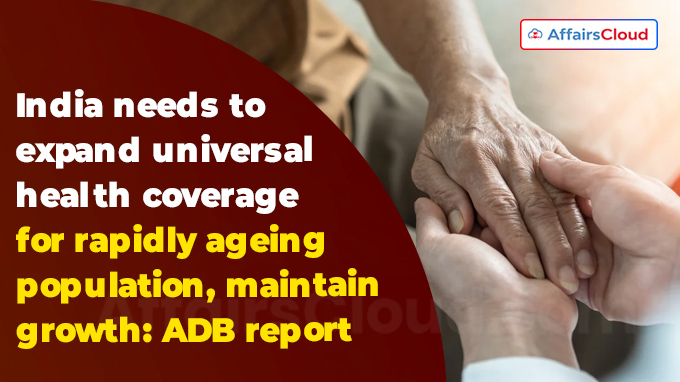 According to the inaugural ‘Aging Well in Asia: Asian Development Policy Report‘ released by the Asian Development Bank (ADB) on 2nd May 2024, India has the lowest health insurance coverage among older people standing at only 21%.
According to the inaugural ‘Aging Well in Asia: Asian Development Policy Report‘ released by the Asian Development Bank (ADB) on 2nd May 2024, India has the lowest health insurance coverage among older people standing at only 21%.
- While, South Korea and Thailand, have already achieved universal health coverage.
- The report emphasizes the urgency for India to expand universal health coverage to support its rapidly aging population and maintain growth momentum
What is in the report?
The report examines progress in Asia and the Pacific in preparing for and achieving well-being among older people.
It explores 4 dimensions of well-being: health, productive work, economic security, and social engagement.
Key Findings:
The dataset on older people in nine economies in developing Asia found that,
i.On average 57% of older people have at least one diagnosed noncommunicable disease (NCD), but only 40% receive regular health checks and 43% of older people with functional limitation lack long-term care.
ii.Up to 94% of workers aged 65+ in Asia are employed in the informal sector.
The coverage of social pensions is significantly higher than that of contributory pensions, reaching 46% of older persons, on average.
Highlights:
i.The aging population in Asia and the Pacific is set to nearly double by 2050 to 1.2 billion or 25.2% of the regional population from 13.5% in 2022, emphasizing the need for pension, welfare, and healthcare programs.
- The report urged Governments to invest in health, education, skills, and retirement preparedness.
ii.The new financial preparedness index shows the share of financially prepared near-old people are as high as 86% in Japan and 73% in India. It is lower in China and South Korea at 64% and 58% respectively.
iii.In India, China, and South Korea, 80-90% of retirement finances come from private income and assets, not public pensions or social assistance.
iv.The report notes that from 2022 to 2050, life expectancy at age 60 is forecasted to increase by 3.7 years for women and 4.1 years for men, raising the average regional life expectancy at age 60 to 25.3 years for women and 22.3 years for men.
v.Older women in India expected to see highest life expectancy increase (6.4 years), followed by Kazakhstan; Georgia; and Hong Kong, China at 4.6 years.
- For older men, Armenia will top at 6.1 years, followed by India (5.7 years) and Georgia (5.2 years).
vi.40% of people over 60 in Asia-Pacific lack pension access, with women disproportionately affected due to unpaid domestic work.
vii. The average labor force participation rate for people aged 65 and over was 32.0% for men, and 15.2% for women.
Indian Scenario:
i.India is enhancing health insurance for older citizens through schemes like Ayushman Bharat, which covers the bottom quartile.
Insurance Regulatory and Development Authority of India (IRDAI) removed the age limit of 65 for buying health insurance with effect from 1st April 2024, aiming for a more inclusive healthcare system.
ii.But, apart from above, India also needs to extend essential services to optimize older people’s physical and functional capacity.
- In Bangladesh, Indonesia, and India, over half of those lacking healthcare access are in the bottom two wealth quintiles.
iii.Notably, India’s economic growth impact from aging population in 2031-2040 is expected to be lower due to its young population demographs.
Recent Related News:
i.The Department of Economic Affairs (DEA) of Ministry of Finance (MoF) and ADB has signed a USD 200 million loan agreement (Ordinary Operations) for the ‘Climate Resilient Brahmaputra Integrated Flood and Riverbank Erosion Risk Management(FRERM) Project in Assam’.
ii.ADB has appointed Mio Oka as its new Country Director for India.Mio Oka will take over from the incumbent Takeo Konishi who has been elevated as ADB Director General for South Asia.
About Asian Development Bank (ADB):
President– Masatsugu Asakawa
Headquarters– Mandaluyong City, Metro Manila, Philippines
Establishment– 1966
Members– 68 members (49 are within Asia and the Pacific and 19 outside)




